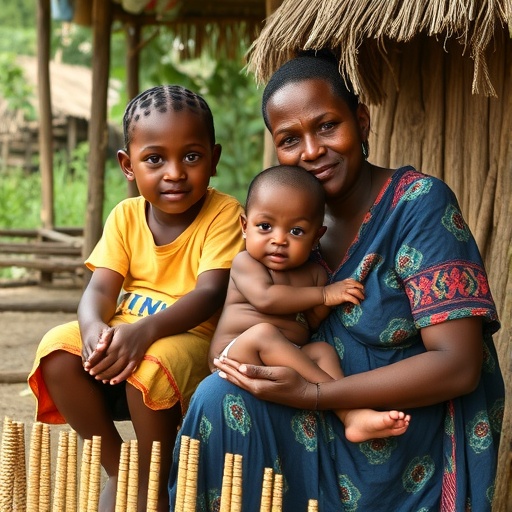In recent years, the global decline in fertility rates has attracted considerable attention from researchers and policymakers alike. However, much of this focus has centered on developed nations, leaving a significant gap in our understanding of reproductive behaviors in developing countries. A groundbreaking study led by Zachary Neal and Jennifer Neal from Michigan State University now challenges this narrow perspective by revealing a surprisingly high prevalence of childfree individuals in developing regions, a demographic previously understudied and often overlooked in global fertility discourse.
This pioneering research, published in the open-access journal PLOS One on November 12, 2025, leveraged a novel computational approach tailored specifically for data from the Demographic and Health Surveys (DHS) Program. The DHS program, a longstanding collaboration between the U.S. and international partners, systematically collects extensive fertility and health-related data from a wide array of developing nations. The newly designed software enabled the researchers to undertake a detailed and nuanced analysis of data spanning from 2014 to 2023, encompassing more than two million respondents across 51 developing countries.
By honing in on childfree individuals—those who have not had children and explicitly do not intend to have any—the study brought to light patterns that defy common assumptions. Contrary to the prevailing view that childfreedom is predominantly a phenomenon of wealthy, highly developed societies, the data revealed considerable variation in childfree prevalence across developing countries. For instance, among single women aged 15 to 29 in Southeast Asia, the proportion of those choosing a childfree life ranged dramatically: 7.3% in the Philippines compared to a mere 0.4% in Indonesia.
The breadth of the study was striking, examining 37,366 childfree individuals within the vast dataset, underscoring the scale and relevance of this demographic. Papua New Guinea emerged as a particularly notable case, with an unprecedented 15.6% of single women in the specified age bracket reporting a childfree status. On the other end of the spectrum, Liberia recorded the lowest prevalence at just 0.3%, highlighting the profound heterogeneity in reproductive choices within and between regions.
Delving deeper into the predictors of this phenomenon, the researchers investigated the relationship between childfree prevalence and various national development indices. The Human Development Index (HDI), a composite measure of health, education, and standard of living, emerged as a significant correlate. Countries with lower HDI scores, like Chad, exhibited childfree rates around 1%, whereas those with higher human development, such as Turkey, had childfree rates approximating 6%. This trend suggests that socioeconomic and infrastructural factors meaningfully shape individuals’ reproductive decisions even in less affluent contexts.
Beyond HDI, the study explored broader social dimensions such as gender equality and political freedom. Although these factors were associated with childfreedom to a lesser degree than human development, their influence was nonetheless apparent. The results imply that political and social structures enabling personal autonomy and gender parity may foster environments where the choice to remain childfree is more accessible and socially accepted.
From a methodological standpoint, this study represents a significant innovation in population dynamics research. The development and application of specialized software to parse complex DHS data allowed for a level of granularity and precision previously unattained. This advancement facilitates more rigorous analyses of life course choices and demographic patterns in regions where data heterogeneity and collection challenges have historically limited scholarly inquiry.
These findings resonate profoundly in the context of global discussions about reproductive health and rights. Understanding the prevalence and predictors of childfreedom in developing countries provides crucial insight into the diverse ways individuals navigate family planning in response to their socio-political and economic environments. Such knowledge is vital for crafting responsive health policies and support systems that honor individual reproductive autonomy while addressing broader demographic shifts.
Importantly, the study challenges simplistic narratives about the global fertility decline by emphasizing the role of personal choice alongside macroeconomic and cultural influences. The recognition that childfreedom is not confined to affluent societies but manifests significantly across developing regions invites a reevaluation of assumptions about fertility intentions and their determinants.
Moreover, insights gleaned from this research could have far-reaching implications for international health organizations, government agencies, and advocacy groups working to enhance reproductive health services. Tailoring programs to acknowledge the presence and needs of childfree populations can improve inclusivity and effectiveness, ensuring that non-parent individuals are not marginalized in health discourse and policy.
The researchers caution that their study represents an initial foray into a complex demographic feature, urging further investigation to unpack the nuanced motivations, cultural contexts, and potential consequences of childfreedom in diverse developing-country settings. Nonetheless, their work provides an invaluable foundation for such research, highlighting the importance of integrating advanced data analytical tools with comprehensive survey data.
By broadening the understanding of reproductive choices in the global South, this study illuminates a dynamic component of demographic change that intersects with human rights, societal norms, and economic development. In doing so, it opens new avenues for interdisciplinary inquiry and proactive policy-making aimed at supporting the full spectrum of reproductive decisions.
As Neal and Neal aptly conclude, the rising visibility of childfree individuals worldwide underscores a universal shift in how people conceive of family, success, and personal fulfillment. Recognizing childfreedom as a legitimate and prevalent choice in both wealthy and developing nations enhances the global narrative on population trends and individual agency, fostering a more inclusive and accurate demographic science.
Subject of Research: People
Article Title: Prevalence and predictors of childfree people in developing countries
News Publication Date: 12-Nov-2025
Web References: http://dx.doi.org/10.1371/journal.pone.0333906
References: Neal ZP, Neal JW (2025) Prevalence and predictors of childfree people in developing countries. PLoS One 20(11): e0333906.
Image Credits: Neal, Neal, 2025, PLOS One, CC-BY 4.0
Keywords: childfree, fertility decline, developing countries, reproductive health, demographic study, Human Development Index, gender equality, political freedom, population dynamics, DHS Program, fertility data, sociology




